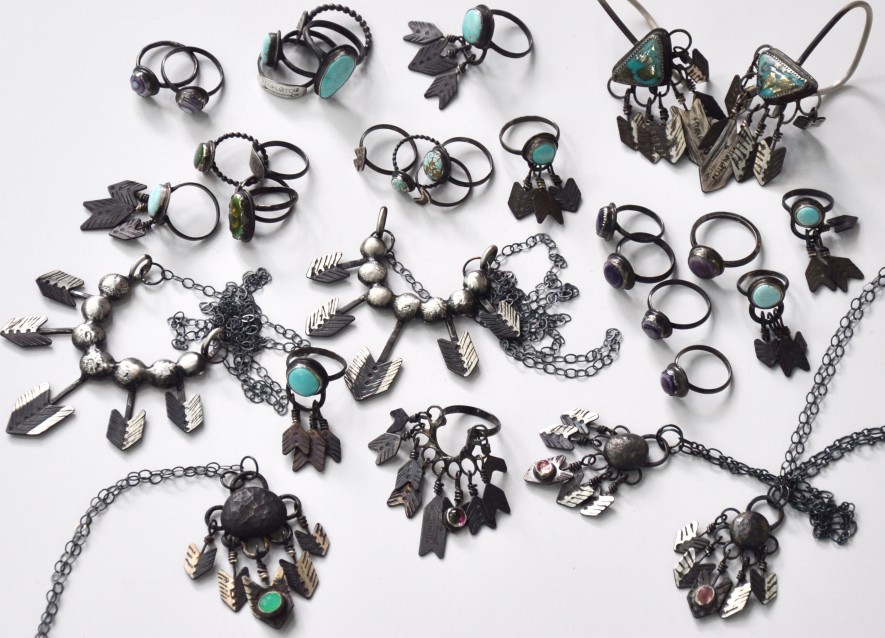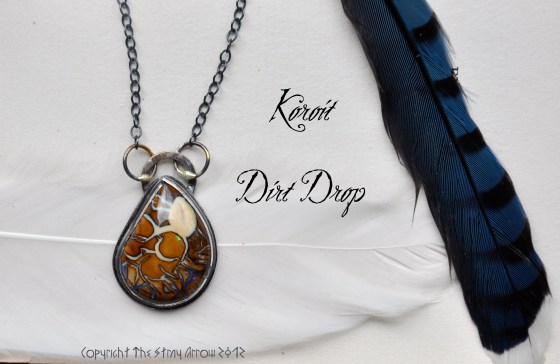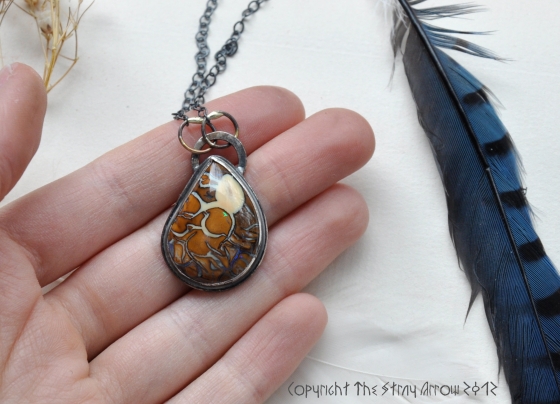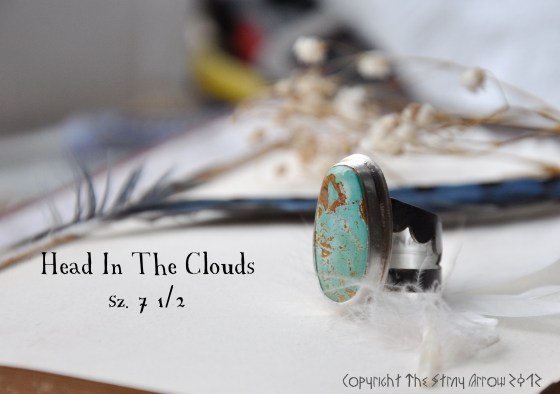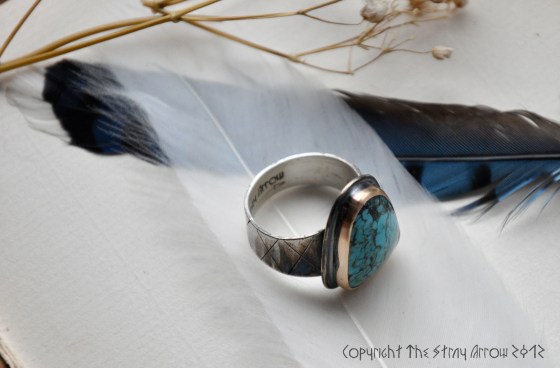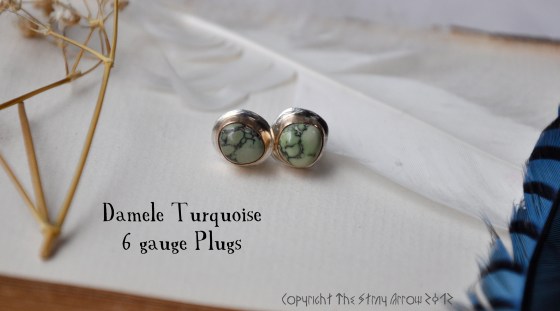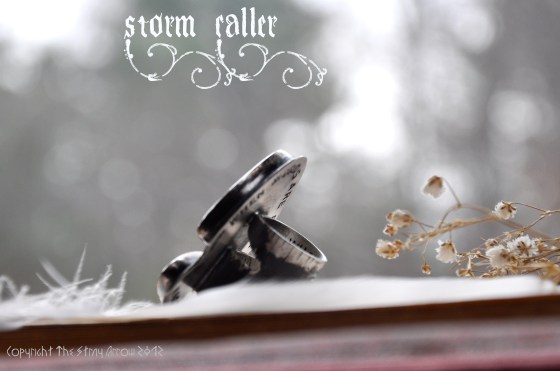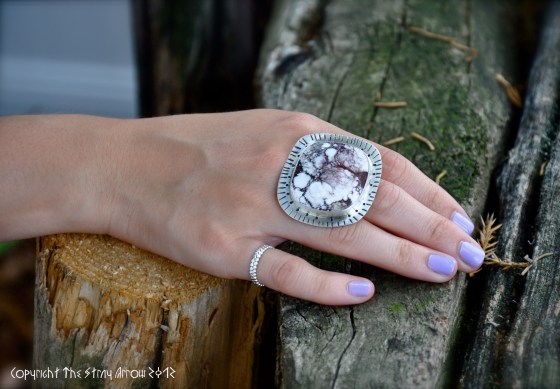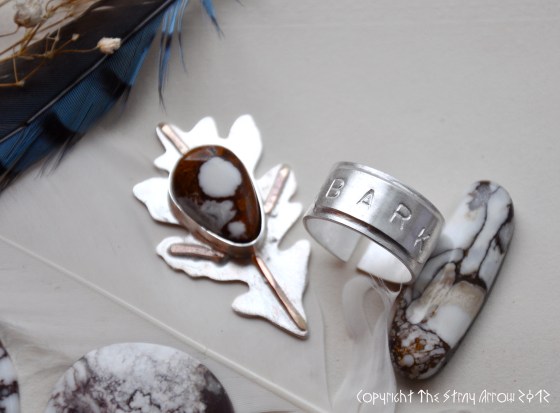Time to crack open the Treasure Chest…

*
A COMPREHENSIVE TURQUOISE GUIDE FOR CUSTOMERS AND OTHER ENTHUSIASTS
A DISCLAIMER: I am an enthusiast. I have gathered all of the information here by myself over years spent drooling over and collecting rocks. I have not been trained, schooled, or educated beyond my own research. I am not a lapidary artist, mineralogist, gemologist, mine owner, or any other kind of authority on gems, stones, or minerals. I am simply sharing information I have gathered through reading and observation, and my opinions. If you see something mislabeled please –kindly- let me know.
For this Turquoise Guide, the main aim is to educate anyone and everyone who would like to know how to identify the quality of what they’re buying (many of these factors can be applied to all stones, not just turquoise). A three star grading system will be used solely within my shop for my own jewelry pieces, and will be explained with examples towards the bottom of this post.
I will be using select terms in repetition for describing aspects of stone quality. These are also just handy in general. Here is a list of some terms that may prove useful with a few example pictures:
Rough/Nugget: when a stone is in a nugget or chunk rock form straight from the earth.
Slab: After the rough/nugget stage rocks are cut into working slabs (from what I’ve seen around ¼” thick), that a lapidary artist will trace in pencil where to cut cabochons.
Preform: The shape of a cabochon cut from a slab and roughly started.

(click picture to enlarge)
Cabochon (cab for short): Stones used in jewelry, mainly for bezel setting. Cabochons are flat on the bottom and polish domed on the top for easy setting.
Doublet: When a stone or gem has some kind of backing. This can been seen in “opal doublets” or triplets-which is done to save money. In the case of turquoise, however, it is often done in the lapidary process to work with the stone when shaping and polishing. Turquoise is very soft compared to other mineral types, so many natural turquoise stones will more often than not have a resin backing. This can actually be handy when buying turquoise because stabilized, or enhanced turquoise won’t have any resin backing.
Enhanced: When natural stones are treated to improve colour, finish, strength, or other characteristics. This lessens quality as “natural” is more desirable. Enhancement methods can include surface coating, filling cracks, oiling (usually done to emeralds to hide fracturing), waxing, dyes etc.
Stabilized: A form of stone enhancement where plastic resins are forced into the pores of a stone to harden and brighten colour. The only way I know of to test this is to take a heated pin to the stone and see if you smell plastic.
Fracture: A crack or break in the rock. Fractures can also be teeny tiny river shaped cracks in the surface of a stone, which is common among older stock pieces, natural pieces, or especially soft pieces. A stone can often still be used with fractures as long as there is no chipping, but they are not desired.
Porous: A stone with tiny holes in the surface. While these can still be beautiful, things like water and oils from skin can get into the rock and change it’s colouring over time.
Value: Spectrum of light to dark.
Hue: Essentially colour.
Saturation: The intensity, depth, and vividness of colour.
Chroma: Purity or intensity of colour.
Luster: State or quality of shine.
Water Web: When a stone features a webbing pattern of two different tones/values of turquoise without a host rock.

(click on picture to enlarge)
TURQUOISE & QUALITY.
LOCATION:
All of the turquoise I collect comes from the American Southwest. Other turquoise hubs that I know of are China and Persia. Persia produces a lot of great quality blue turquoise that can also sometimes be seen in Native American Indian jewelry. China produces a lot of enhanced or stabilized turquoise, as well as quality turquoise like that of the Hubei Mine. I’m sure there are other “hubs” that produce turquoise, but these are the prominent three I’ve been exposed to constantly while rock roaming.
In theory, a mine owner or their employees will sell rough to lapidary artists who then create cabochons or other stone styles from the rough. Sometimes a mine will produce turquoise in several stages for sale (rough, slabs, cabs). Essentially what it comes down to is it is on the mine owners, operators, employees, buyers, lapidary artists, and any other middle folks between digging the rock out of the earth to the hands of a jeweler to keep the Mine location of the turquoise properly labeled. This is a very hopeful practice. Many people say you can never really know where a stone comes from. I met a man once who could tell you the exact Mine or Mine pit a stone was from just by looking at it. It really depends on how much exposure you have to turquoise, and how close you are to the source. Sometimes a stone origin can be evident if a mine has signature characteristics that NO OTHER MINE HAS. Damele and Lander Blue come to my mind (watch out though! Highly prized Lander Blue is often poorly faked. Anything that isn’t sold for hundreds a carat ain’t real folks). Mines that are really close in location and colour qualities are harder. For instance Crow Springs, Ajax, Royston, and Pilot Mountain mines can be confused very easily. While most stones are only graded in quality based on the condition of the stone, turquoise also factors in location and colour.
COLOUR/PATTERN:
Colour is always subjective. Back in the day deep saturated blues were considered prized. Solid colours were considered higher quality. Nowadays pale blues, deep greens, and everything in between has become collectible. Patterns make for more unique stones, and unique stones are always more sought after. No matter what, a mainstay in quality is spider-webbed turquoise. A clear webbing pattern is always the highest quality. What I look for in colour is uniqueness and chroma/saturation. The deeper colour of the stone the better in my book. Different hues, like mixed blues and greens, are also a hit. I veer towards the collectible “military greens” often seen in Manassa, Blue Gem, and Royston turquoise. Rare hues are also what I cherish, as I’m a bit of a colour nerd. Anything topographical or “earthy” I’ll jump on. Pale blues can also be beautiful, especially the “white turquoise” of mines like Dry Creek. Any kind of webbing, boulder cut, or water web is always special and a bit harder to come by. If a colour looks “chalky”, or less saturated, I’ll personally consider it lower quality. An example of this is two different rings I made in the same “Green Grasses” theme. Both cabs were natural from the Crow Springs Mine. One is a deeper green and I considered that to be more prized.


TREATMENT:
The highest quality stones are natural. Always. Natural stones are often, but not always backed or mounted. If a stone is too soft it is often stabilized or enhanced in some way. High Grade natural turquoise is a small percentage of turquoise produced from a mine that is hard and can take a good polish. There are always exceptions based on location. For example a webbed Damele turquoise with one or two chips may be prized more than a hard, high polished Kingman mine stone. There is always subjective compromise based on location, pattern, and colouring. The general consensus is natural>treated every time. The difficult part for many is being able to tell when a stone is enhanced in any way. For me, I think stabilized stones look dulled out and more plastic like. While it is done to strengthen and brighten colour, the overall appearance is waxy and too high polished to be believable. Then again, there really is no way of knowing unless you know and trust the source or get it professionally tested.
OTHER FACTORS:
The highest grades of turquoise will be either the perfect hue (robin’s egg blue), spider-webbed, water-webbed, birds eye, include pyrite, fossils, dendrites, or be extremely rare based on mine location. Few are able to obtain and use turquoise of this grade and it is what I would consider to be “museum” or top quality. Any of these types of turquoise that aren’t extremely hard, cut well, and polished I would consider to be “good/decent” quality. Natural turquoise that is a jewelry standard usually features one solid colour or decent matrix. I prize turquoise with pyrite, tight spider and water webs, and rare mines.
*********************************
TURQUOISE GRADING SYSTEM FOR THE TURQUOISE STONES I USE IN MY OWN JEWELRY:
A three star (***) system will be seen displayed with each piece of jewelry I create involving turquoise. A single star will encompass the majority of turquoise used. To the best of my knowledge, this will always be natural turquoise. One star will stand for wholesale to decent grade turquoise. Two stars will stand for higher grade turquoise or rarer mines. Three stars will rarely be seen and reserved solely for my best top-notch turquoise stones collected and used.
These stars will appear at the bottom left corner of the first photo for every Etsy turquoise listing from now on. The star shown is how I will be grading the stone in the jewelry piece.
If you see a stone and fall in love, but it is low quality-it doesn’t matter! Anything has the potential for beauty. This guide is merely to inspire confidence in any customer, to establish price points, and for sharing information. I care about what I use, produce, and offer to people. There’s nothing better than someone enjoying something I’ve created. I love turquoise, and I want you to love it as well. Sometimes I also use rough, uncut, or unpolished turquoise. These stones will also be graded with one star. I use these because of either where they come from, the colour, or just because they are really, really cool rocks. I love the thought of the process they go through coming out of the earth, and capturing it in an early stage for jewelry use is exciting.
WHEN BUYING JEWELRY:
Sometimes I will actually snag and use a turquoise stone when I do not know, or am not sure of the mine. This may be because the stone is obviously of amazing quality, or because I just think it’s darn nifty. A stone is a stone, after all. When you buy jewelry, from me or any other jeweler or place out there, make sure people tell you what you’re getting! If the “main stone” of a piece is listed as Sleeping Beauty mine, do NOT assume this covers any other turquoise stones in that piece that are not identified. I’ve seen this a lot where someone will use one nice stone, and surround it by cheap stabilized Chinese turquoise. If they don’t know where it’s from, they should tell you. It may or may not lessen the personal value you project towards that jewelry piece, but you should have all the facts. Most people do not know the mines of the stones they use, and it should not take away from the piece unless you’re aiming to collect a mine.
Secondly, all sides of what you are planning to buy should be seen. Sometimes there is a limit to how many photos of each item a seller can post depending on the selling platform. If I do not post a picture of the back of an item, it is usually because of this reason or lack of detailing on the back. Never hesitate to ask for more photos from anyone to see all views.
*PRICING*
If the price is too good to be true, it usually is. Rare turquoise is RARE, and thus expensive. Once a mine is depleted, all that is left is uncut rough or old stock cab collections on the market to be used. If someone is selling “natural”, “rare” turquoise, or anything from a specific mine, at a low cost, they are either not making any money or being dishonest. My particular prices are extremely fair for what the turquoise stones themselves alone retail for, or cost for collectors. I have worked for several years to search out reputable and trustworthy sources. If you have a questions about a stone used in my jewelry, feel free to ask.
If you have any questions about any of my work, never hesitate to ask me. Be nice though, and remember we’re all human.
*********************************************************************************************************
BELOW:
TURQUOISE EXAMPLES & TURQUOISE IN JEWELRY EXAMPLES.
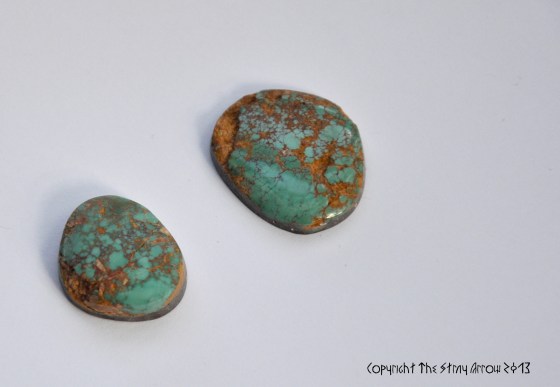
^these are rough cabs from the Crow Springs mine. I would not use them in my jewelry but collect them because I like rocks and think they’re nifty.
*
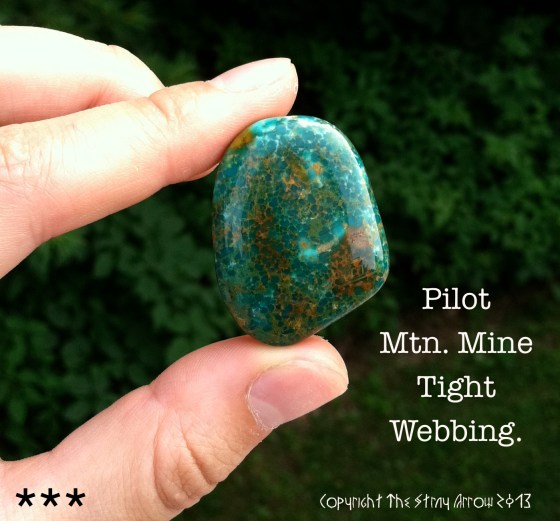
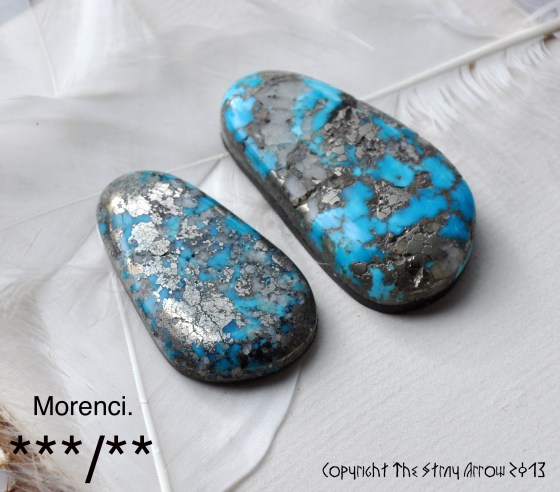

^These four all look similar but are from different mines.
(L to R: New Lander, Lander County, Apache, Widow Maker)
*

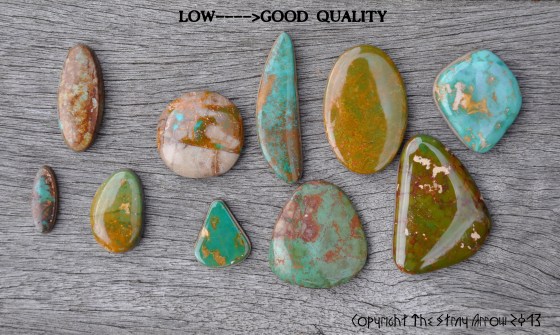
^Crow Springs Mine.
*
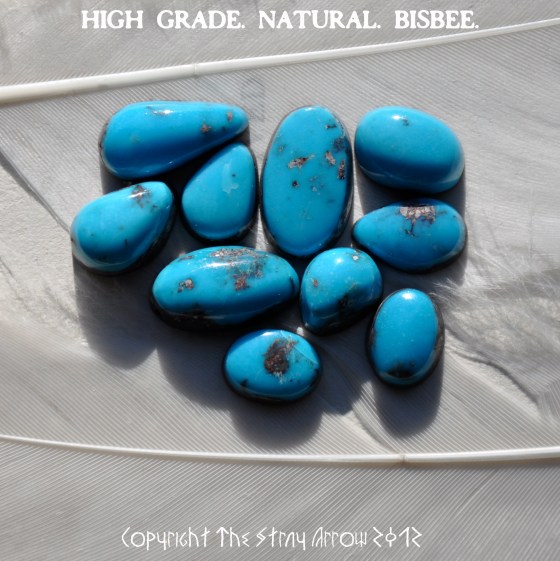 ^an indicating mark of Bisbee Blue is the warm deep chocolate brown host rock/matrix
^an indicating mark of Bisbee Blue is the warm deep chocolate brown host rock/matrix
*
~*FOR JEWELRY EXAMPLES CLICK ON THE PICTURE TO SEE THE ITEM*~

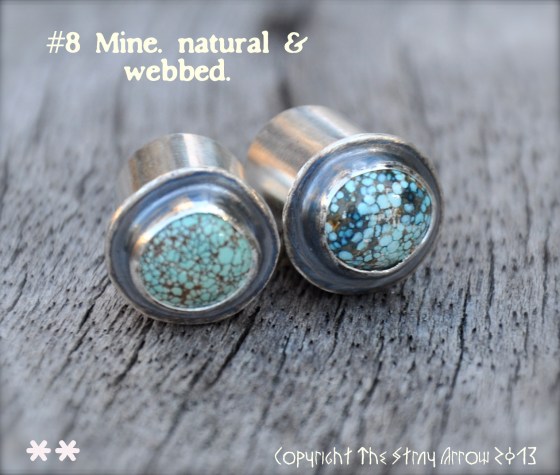





^these little Manassa post earrings are of decent quality and have a lot of beautiful teeny patterning, hue, and chroma variations.
*

^custom 1″ Manassa Mine plugs with solid and ribbon cut turquoise.
*


^while the Mine is unknown, this is natural, webbed, Southwestern turquoise.
*
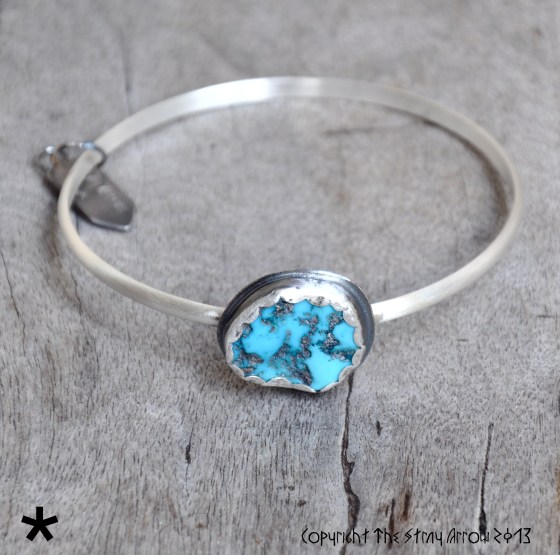
^certain Mines, like a lot of Kingman Ithaca Peak, are actually popular in this more “nugget like” form. They are collected this way and still prove of great quality.

 ^this last one is unknown, Kingman mine is usually more blue as seen in the two previous.
^this last one is unknown, Kingman mine is usually more blue as seen in the two previous.

^lower quality White Buffalo- this ring is one of my personal pieces i made for myself.
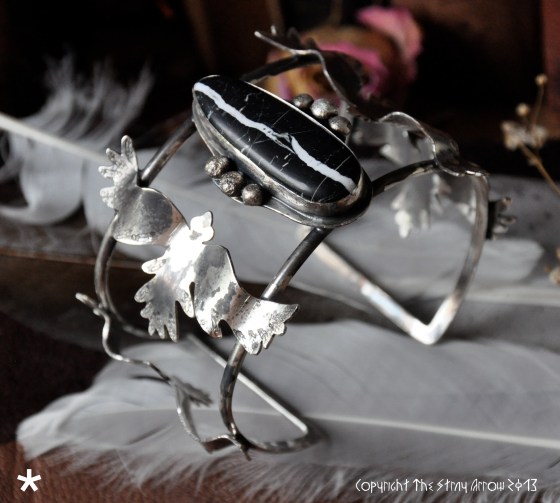
^custom Buffalo&Crow cuff, with White Buffalo ribbon cut. Ribbon cut and boulder turquoise is automatically considered a little lower in quality simply because there is less turquoise involved and more host rock. These types have become collectible in their own right for contrast between the turquoise and host rock, and patterning.
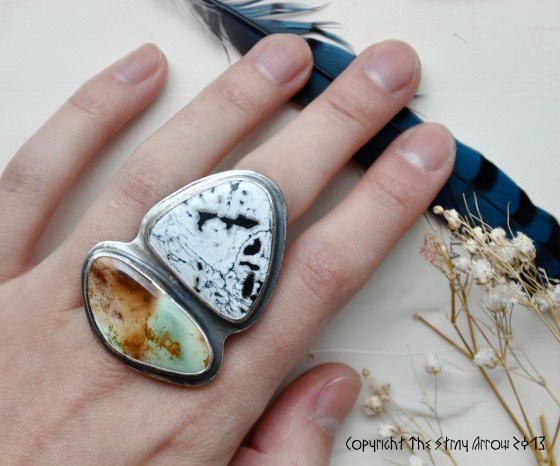
^high quality White Buffalo, with smooth even polish, hard surface, and clarity between the white and black chert host rock matrix.
*****************
THAT’S IT FOLKS.
As always, feel free to message me with any questions, concerns, etc.
Thanks for reading!
xx Stray Arrow.
*these are my own notes from years of study and research. Copyrighted by Stasia Salvucci 2013. Please do not quote or use without permission.
